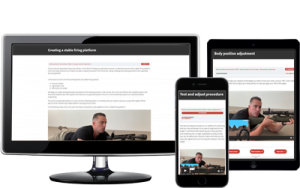No products in the cart.


After establishing a stable firing platform, achieving natural alignment and completing the test and adjust procedure, you still won’t hit the target if your trigger manipulation is not executed well.
Too few rifle owners do this well when it comes to finally firing the round.
What many shooters do not realize is that the smallest movements made when squeezing the trigger will cause your rifle to move out of alignment and miss your target.
Before you touch the trigger, you need to ensure that your trigger hand is not gripping too tightly on the weapon.
Ideally it should really only be used as a counter hold to keep the rifle vertical, not to support the weight of the rifle.
The weight of the rifle should be supported by your fore-grip, leaving your trigger hand to focus on the fine motor movements to manipulate the trigger.
There are three things to master for effective trigger manipulation, they are:
To correctly place your finger on the trigger you want to use the center of the top pad of your index finger; do not wrap your finger right around the trigger.
This will decrease your dexterity and negatively impact your natural alignment when you squeeze the trigger.

Once your index finger’s top pad is correctly placed on the trigger, you should commence your pre-shot breathing cycle whilst gradually applying pressure to the trigger.
How much you will need to squeeze is totally dependent on your rifle and your trigger.
You will need to become familiar with your trigger and learn how much pressure is required for it to break.
You should aim for the shot to be released at the bottom of your breath, or full exhalation, and ensure it is consistent with every round (for more information on shooting breathing cycles check out the article we did earlier about it).
Now there are two common problems that beginner shooters run into during the trigger squeeze and they are snatching the trigger and flinching.
A big mistake new shooters make is snatching the trigger rather than gradually increasing the trigger squeeze until it breaks.
Whilst not quite as dangerous as the above clip, this sudden pulling motion moves the barrel down and to the right or left (depending on your trigger hand).
This will cause your shots to hit low and to the right or left of your point of aim.
Flinching is another problem for shooters and it happens to all shooters especially when they first start shooting, but can develop for experienced shooters too.

This is because when you shoot your head is literally inches from an
explosion.
The explosion (a.k.a the shot being fired) creates a very loud noise and a small concussion.
The flinch response is a natural physiological response to this occurring.
This is especially true when firing larger caliber rifles as the noise, explosion and therefore recoil of the rifle is more prominent.
Most of the time shooters do it without even realizing.
If a shooter flinches just prior to firing the shot they will move their point of aim off target.
It tends to occur more when shooters anticipate the breaking of the trigger, rather than having it break from a gradual increase in pressure.
The best way to diagnose this is by dry-firing.
Note: Sometimes if a shooter knows that there is no round in the chamber then they will not flinch. If this is the case, one technique that is effective is to have a magazine loaded with 5 rounds and in a random place put a dummy round or snap cap. This will produce a better natural reaction and expose the flinch.
If you have developed a flinch the best way to overcome it is
through dry-firing and good trigger squeeze technique.
To avoid developing a flinch, try not to anticipate the point at which the
trigger breaks.
There are a number of ways to fix a flinch and we may do an article on it in the future, but for now here is a good article on how to fix a flinch.
Once the round is fired, do not release the trigger straight away.
Instead it is recommended to count a cadence of “1… 2… ” in your head before slowly releasing the trigger.
It is important not to let go quickly so you can maintain the same point of aim and light pressure on the trigger for a subsequent shot.
This will also assist you in observing your fall of shot.
The less movement between shots the better!
Trigger manipulation is a critical skill for accurate shooting, and often the one that can have the biggest impact on improving your accuracy.
If you remember the three components: Finger placement, Controlled Squeeze, and Controlled release you will be well on your way to better shooting.

 Find Out More
Find Out More